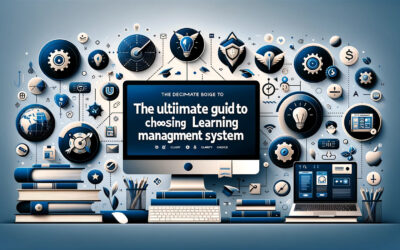Introduction
Implementing a Learning Management System (LMS) is vital for organizations aiming to boost their training and educational programs. Success in this endeavor relies on clear objectives, stakeholder engagement, and strategic decisions. Defining goals guides the implementation process, while involving stakeholders fosters collaboration and ensures diverse perspectives. Key steps include selecting the right LMS, providing training, customization, ongoing evaluation, and staying updated with technology trends.
Define Clear Objectives
Before implementing a Learning Management System (LMS), it’s crucial to establish clear objectives. These objectives serve as the guiding principles for the entire process, ensuring that all efforts are aligned with the organization’s goals. Clear objectives provide a roadmap for LMS implementation, helping to prioritize tasks, allocate resources effectively, and measure success. Whether the goal is to improve employee training, enhance student learning outcomes, streamline administrative processes, or expand educational reach, articulating clear objectives is essential for driving the LMS implementation forward.
Involve Stakeholders
The success of an LMS implementation depends heavily on the involvement of key stakeholders throughout the process. Stakeholders may include educators, administrators, IT personnel, and learners themselves. Involving stakeholders from the outset ensures that their perspectives, insights, and concerns are considered in decision-making processes. By fostering a collaborative approach, organizations can harness the collective expertise and buy-in of stakeholders, leading to a more successful LMS implementation. Engaging stakeholders also promotes a sense of ownership and accountability, fostering a culture of collaboration and continuous improvement.
Select the Right LMS
Choosing the right Learning Management System (LMS) is a critical decision that can significantly impact the success of an organization’s training and educational initiatives. When selecting an LMS, it’s essential to conduct thorough research and evaluation to identify a platform that aligns with the organization’s goals, requirements, and budget. Factors to consider include the platform’s features and functionalities, scalability, ease of use, integration capabilities, and vendor support. Organizations should also seek input from key stakeholders and conduct pilot testing to ensure the chosen LMS meets their needs and expectations. By selecting the right LMS, organizations can maximize the return on investment and achieve their learning and development objectives effectively.
Provide Adequate Training
One of the key factors in the successful implementation of a Learning Management System (LMS) is providing adequate training to users. Administrators, instructors, and learners alike need to be familiarized with the features and functionalities of the LMS to effectively utilize its capabilities. Training programs should be tailored to the specific needs and roles of users, providing hands-on experience and ongoing support. By investing in comprehensive training initiatives, organizations can empower users to leverage the full potential of the LMS, driving engagement, productivity, and learning outcomes.
Customize for Your Needs
Every organization has unique requirements and preferences when it comes to learning and development. Therefore, it’s essential to customize the Learning Management System (LMS) to suit the specific needs and branding of the organization. Customization options may include branding and interface customization, content authoring tools, user permissions, and reporting capabilities. By tailoring the LMS to align with organizational goals, workflows, and culture, organizations can enhance user adoption, engagement, and satisfaction. Customization also allows organizations to differentiate their learning experiences and create a cohesive brand identity across training initiatives.
Evaluate Effectiveness
Once the Learning Management System (LMS) is implemented, it’s crucial to continually evaluate its effectiveness. Regular assessments help identify areas of improvement and ensure that the LMS remains aligned with the organization’s evolving needs and goals. Metrics such as user satisfaction, course completion rates, learner engagement, and performance outcomes can provide valuable insights into the LMS’s impact on learning and development initiatives. By monitoring key performance indicators and soliciting feedback from users, organizations can make data-driven decisions to optimize the LMS and enhance its overall effectiveness.
Stay Updated with Technology Trends
In today’s rapidly evolving technological landscape, it’s essential for organizations to stay updated with the latest trends and advancements in learning technology. This includes exploring emerging technologies such as artificial intelligence, machine learning, virtual reality, and gamification, which have the potential to transform the learning experience and improve outcomes. By staying abreast of technology trends, organizations can identify opportunities to enhance their LMS capabilities, innovate their learning strategies, and provide learners with engaging and impactful educational experiences. Additionally, keeping pace with technological advancements ensures that the LMS remains relevant and competitive in the ever-changing educational landscape.
Conclusion
Implementing an LMS requires a strategic approach for success. By setting clear objectives, involving stakeholders, selecting the right LMS, providing training, customization, ongoing evaluation, and staying updated with technology trends, organizations can maximize the impact of their learning initiatives. With careful planning and execution, an LMS becomes a powerful tool for driving engagement, productivity, and learning outcomes effectively.
Search
Categories
- AI 3
- Analytics & Data Science 16
- Blogs 7
- Brand Identity 22
- Business 10
- CMS & LMS 22
- Development 1
- Digital Marketing 19
- Digital Signage 12
- E-commerce 6
- Education & E-Learning 1
- Enterprise solution 15
- Events 1
- Internet of Things 9
- Mobile App Development 15
- News 5
- Open Source Development 12
- SEO Search engine optimization 2
- Staff Augmentation 1
- Uncategorized 4
- Web Design 1
- Web Development 19
- Web Security and Performance 18
- Website Development 1
- WordPress Development 3






